
Phobaeticus serratipes is a species of stick insect that at one time was the longest known insect, with one female specimen recorded as being 555 mm long. This measurement includes the legs fully extended front and rear, and the actual length of the body alone is considerably shorter. This insect is endemic to Malaysia and Singapore. It is a popular species among those who raise stick insects.

Phyllium is the largest and most widespread genus of leaf insects in the family Phylliidae. They can be found in the Indian subcontinent through to Southeast Asia and Australasia.

Necrosciinae is a subfamily of the stick insect family Lonchodidae, with its greatest diversity in South-East Asia.
Asceles is a genus from the stick insect family Diapheromeridae. Some of the species of Asceles have a distribution in Malaysia and Singapore.
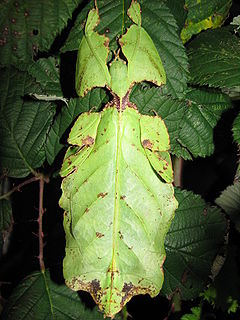
Phyllium giganteum, commonly known as the Giant Malaysian Leaf insect, is a species of leaf-insect described from Malaysia by Hausleithner in 1984 and placed in the genus Phyllium and family Phylliidae. Phyllium giganteum are the largest species belonging to the genus Phyllium reaching 105mm in size. They are found most abundantly in the west Malaysian tropics. The females typically have large elytra that lie edge to edge on the abdomen and tend to lack hind wings making them usually flightless. Males have small elytra and sometimes transparent non-leaflike functional hind wings. Phyllium giganteum found in the wild tend to be mostly females and the first male of this species was not found until 1994. The species has the ability to reproduce through parthenogenesis meaning the females are asexual. The primary reproductive pattern in the wild is unknown however in captivity, the females reproduce primary through parthenogenesis. Eggs tend to be brown or black and glossy and resemble the look of seeds. They hatch around 6 months after breeding. Newly hatched young nymphs tend to be wingless and brown or reddish in color. They develop their green color after feeding on leaves. Both the adult and larval stages are phytophagous meaning they feed on plants. The main plant food sources for this species are oak and bramble tree leaves.
Pseudophasma brachypterum is a species of stick insect found in Brazil, Suriname, Guadeloupe and Peru.

Sosibia is an Asian genus of stick insects in the family Diapheromeridae and subfamily Necrosciinae.

Sipyloidea is a genus of stick insects of the family Diapheromeridae. The genus was described by Brunner von Wattenwyl in 1893.

Aschiphasmatidae are a family of stick insects belonging to the suborder Verophasmatodea; they can be found in Indomalaya.
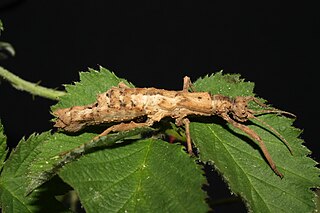
The Heteropterygidae is a family of stick insects belonging to the suborder Verophasmatodea; species can be found in Australasia, East and Southeast Asia.

Prisopodidae is a family of stick insects belonging to the suborder Verophasmatodea and superfamily Aschiphasmatoidea; they can be found in Central and South America, South Africa, India, Indo-China and Malesia.
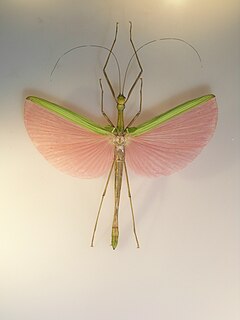
Marmessoidea is an Asian genus of stick insects in the family Diapheromeridae and subfamily Necrosciinae. The native range of species appears to be from India and South-East Asia to the Wallace line.
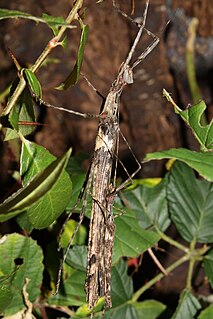
Trachythorax is an Asian genus of stick insects in the family Diapheromeridae and subfamily Necrosciinae. Species have been recorded from the Indian subcontinent, Indo-China, Malesia through to New Guinea.

Necroscia is an Asian genus of stick insects in the family Diapheromeridae and subfamily Necrosciinae. Species have been recorded from South-East Asia.
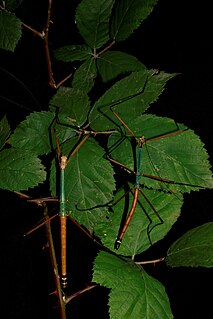
Lopaphus is an Asian genus of stick insects in the family Diapheromeridae and subfamily Necrosciinae. Species have been recorded from India, China and South-East Asia.

Pachymorphinae is a subfamily of stick insects in the family Diapheromeridae. Genera are primarily found in Africa, Asia and Australia.
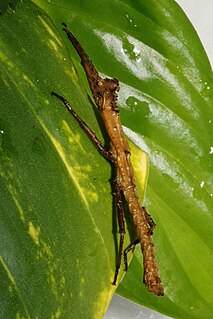
Pylaemenes is an Asian genus of stick insects in the family Heteropterygidae and subfamily Dataminae.

Calvisia is a genus of stick insects in the subfamily Necrosciinae. Species are known to be distributed in temperate and tropical Asia.
Ramulus westwoodii is a species of stick insect first described by James Wood-Mason in 1873 and named in honour of John O. Westwood.

Neoclides is an Asian genus of stick insects in the family Diapheromeridae, subfamily Necrosciinae. Species have a known distribution from: Indo-China, Borneo, Sumatra, Philippines and New Guinea.
















